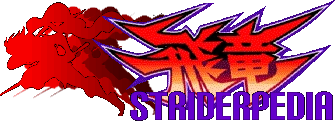- For more information, see Street Fighter series on the Street Fighter Wiki.

The Street Fighter (ストリートファイター) series is a fighting game series developed by Capcom. Initially released in 1987, the series went on to become a massively popular worldwide success and establish many of the standards in the fighting game genre, being considered the main instigator of the genre's popularity peak during the Nineties. Over the years the series has become one of Capcom's most prolific titles, releasing several different video game sequels and spin-offs, as well as films, animated features, comic book series and a large number of merchandising.
Over its long history Street Fighter has amassed a number of references, both overt and subtle, with several of Capcom's other franchises, ranging from little nods and cameos to directly and explicity being part of the same "shared universe". The Strider series is among the series referenced.
Street Fighter II[]
- For more information, see Street Fighter II on the Street Fighter Wiki.
Street Fighter II: The World Warriors is the second game in the series, released in 1991. Sporting a playable roster of 8 characters, it went on to become the most influential and defining title in the fighting game genre, spawning countless imitators and rivals and spreading over all forms of media.
Certain Street Fighter II characters show parallels to characters in the first Strider, which was released only 2 years prior.
- Chun-Li's design sports several parallels to that of Tong Pooh, and reportedly she actually served as the former's inspiration[1]. Both are quick and lithe Chinese warriors with a focus on kick techniques and hairstyles tied into twin buns known as "odango", with Tong Pooh using twin pigtails whereas Chun-Li wears simple decorated twin buns. Akiman confirmed a Kuniang influence in Chun-Li's design on a printed 2012 interview[2], and an early drawing he has shared shows a remarkable resemblance to Tong Pooh[3]. The resemblance wasn't lost on the Gamest staff either, as the very first article covering Street Fighter II states: "She's not Strider Hiryu's Tong Pooh, her name is Chun-Li".[4]
- The character of Balrog (the agile, claw-wielding masked fighter known as Vega in the rest of the world) was possibly named after the Flying Battleship Balrog. Curiously enough, Balrog/Vega and the Balrog's Captain Beard Jr. are both of Spanish nationality.
- The appearance of Gorbachev in Zangief's ending may have been inspired by General Mikiel, a character also inspired by the former Russian president.
At around the same time, there were several proposals for a Strider sequel internally at Capcom. One of them was to utilize the multiple cabinet system from 1993's Street Fighter II: The Tournament Battle for a simultaneous multiplayer-linked sequel. Unfortunately, the fighting game craze kickstarted by Street Fighter II signaled the dead of all such proposals.[5]
Street Fighter Alpha 2[]
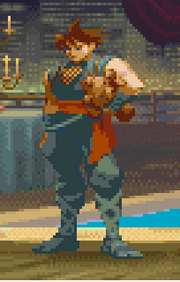
Hiryu in the background of Ken's stage
Street Fighter Alpha is a subseries comprised of three installments and several revisions, with a marked Anime aesthetic inspired by Street Fighter II The Animated Movie. The series serves as an interquel set between the first and second entries.
Hiryu makes a cameo appearance in Street Fighter Alpha 2, in the background of Ken's stage. The stage is set on a yatch in San Franscisco Bay where a birthday party for Ken's girlfriend (and future wife) Eliza is being held. Attending the party are several characters from other Capcom franchises serving as guests, including Hiryu. He can be spotted in the center of the stage, wearing his classic Strider uniform, a bow tie and holding a teddy bear under his arm. Whenever a character connects a Super Combo during battle, Hiryu would throw the teddy bear upwards and then catch it.
As this cameo predates Hiryu's return as a character in Marvel vs. Capcom: Clash of Super Heroes, this appearance lacks his iconic red scarf.
Street Fighter V[]
Street Fighter V is the latest entry in the series, released on 2016 for PlayStation 4 and PC. Zeku, the final Season 2 DLC character revealed in October 2017, is heavily designed around Strider Hiryu and features several references to him, the Strider series and his Marvel vs. Capcom incarnation.
Zeku[]
- For an in-depth article about the character, see Zeku on the Street Fighter Wiki.
Zeku is the 38th Bushinryuu grandmaster and Guy's master, first appearing in Guy's ending from Street Fighter Alpha 2. Zeku disappeared after handing out the title of 39th Grandmaster to Guy, and now has returned seeking to develop a new fighting style and create a new ninja group for the modern times. Zeku's main gameplay gimmick is his ability to switch between two versions of himself: an older Zeku focused mainly on ranged attacks, and a younger Zeku with a quick, close range movelist; this makes Zeku effectively two characters in one.
Although not directly addressed, it is heavily implied Zeku's new ninja group will eventually evolve into the Striders, and he himself is the very first Strider within the Street Fighter continuity:

Zeku's in-game titles, "Original Strider" is the last one in the middle column
- In the final scene of his character story, Zeku has an internal debate with himself about how to name his evolved fighting style. While young Zeku prefers complicated traditional Japanese names such as "Shin Bushinryu", old Zeku thinks an English name would fit better in this global world and lists several English words, "Striders" among them.
- One of Zeku's unlockable titles is "Original Strider".
- The in-game store commentary for Zeku's Battle Costume (which is almost identical to Hiryu's) describes it as a "prototype uniform for the new ninja corps that Zeku is trying to create."
- According to the character setting written for Zeku, he is established to be the "1st generation Strider Hiryu" (初代ストライダー飛竜)[6], with the Strider Hiryu from the 1989 Arcade Strider established to be "the 3rd generation" (三代目) as well as "the second generation of Zeku" (是空の二代))[6], seemingly implying there's a generation between them.
Costumes[]
Zeku's costume in his older appearance shows a slight resemblance to Hiryu, wearing a similar dark blue ninja uniform under a green and yellow sleeveless coat, leg wraps with sandals and dark tabi, and a small, red neckerchief. He also somewhat resembles Kuramoto, the founder and Director of the Striders in the manga, who wears a long sleeved orange/red coat over a blue ninja uniform.
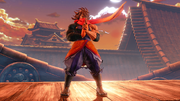
Young Zeku's costume
Zeku's costume in his younger appearance draws heavily from Hiryu's design and color scheme, sporting a dark blue uniform consisting of a backless, sleeveless chain mail shirt and baggy pants, a long red scarf wrapped around his neck and covering his mouth, leg wraps and sandals with blue tabi. The scarf's color turns a brighter orange near its end.
Elements unrelated to Hiryu include a yellow cloth worn around his waist, orange open back fingerless gloves and wrappings covering his right arm entirely.
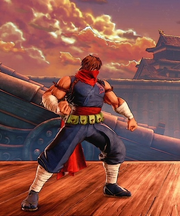
Zeku's Battle Costume (young)
On the other hand, Zeku's Battle Costume is directly Hiryu's standard costume, including a full shinobi shozoku identical to the one worn by Hiryu, white arm and leg wraps, blue tabi with sandals, a red sash and a long red scarf wrapped around his neck and covering his mouth; plus Zeku's hair is trimmed down to closely match Hiryu's. The costume includes a number of non-technological equivalents to some of Hiryu's equipment: a sickle and a two-pronged edged tonfa hanging from his back similar to Hiryu's Climb Sickle and Cypher sword, a pouch belt in place of Hiryu's loose-fitting metallic belt and tied ropes replacing his shoulder leather straps. Original to Zeku's version of this costume is a kasa hat worn by old Zeku, and tied to the back of his younger self.
Both younger Zeku's default and the Battle Costume feature a red kanji embroidered on the chest, just like Hiryu's uniform sporting a red "Hi" kanji (飛, the first kanji on his name). Zeku's costumes wear the "Bu" (武) kanji instead, the first kanji in "Bushinryu".
Animations[]

Comparison of Zeku and Hiryu's animations
A number of animations for both incarnations of Zeku are inspired or based on Hiryu's animations. In his old appearance, Zeku has mostly original animations with a few inspired by Hiryu:
- Zeku's idle stance is loosely similar to Hiryu's stance in the Marvel vs. Capcom series, except with his front hand in a closed fist instead of a hand gesture and his back hand not holding the Cypher. His pose while crouching is identical to Hiryu's as well.
- In his idle stance, Zeku's right arm is bent at the elbow and close to his hips. This resembles the position of Hiryu's right (Cypher-wielding) arm in the original Arcade game's sprite.
- Zeku's entrance into battle has him flying into stage with a ninja kite and dropping to the ground. Although a common ninja element (also used by Ibuki), this appears to be a nod to Hiryu's entrance in stage by means of his Glider.
- Zeku's jump appears based on Hiryu's Double Jump flip from Strider 2, while the pose as he comes down is based on hid posture from Marvel vs. Capcom.
- Zeku's standing Light Punch (LP) has him strike with fully extended fingers in a pose very similar to Hiryu's LP in the Marvel vs. Capcom series. Zeku's crouching version sees him on a pose also reminiscent of Hiryu's crouching LP, albeit he's now punching instead.
- Zeku's standing Light Kick (LK) has him perform a slanted kick while holding his hand up to his chest, a pose loosely similar to Hiryu's LK attack from the Marvel vs. Capcom series. Zeku's crouching version sees him striking a pose very similar to Hiryu's crouching LK, however. Worth noting that both of Hiryu's LK and LP attacks are his only basic moves where he doesn't uses the Cypher.
In his younger appearance, Zeku's animations and basic attacks are a mixture from both Hiryu's and his student Guy's animations.
- One of young Zeku's attacks when switched is a descending heel strike. His pose while falling down, specially the fully outstretched arms, appears loosely based on Hiryu's falling pose in the Arcade original. The move may also be a nod to Hiryu's ability to kill enemies with the tip of his feet while falling down, which was considered an actual move called the "Rotating Jump Kick".
- Zeku's upright walking animation resembles Hiryu's from Strider 2, although both also resemble Guy's walking animation.
- Zeku's forward and backwards jump animation is Hiryu's iconic Cartwheel Jump, where he spins around in mid-air with his limbs fully outstretched. Zeku's neutral jump uses a similar pose to Hiryu's Excalibur move from Marvel vs. Capcom.
- Zeku's standing Heavy Punch (HP) is a perfectly horizontal chop performed in a swinging motion, identical to Hiryu's movement as he performs his basic Cypher Attack. Zeku can follow it up with a reverse-motion chop known as the Kaeshi Saiha (返し災破, lit. Reverse Disaster Cut), mimicking Hiryu's rapid Cypher swinging in the Strider series, where he performs a forward then backwards Cypher swing very fast. "Saiha" appears to be a deliberate naming choice, as it is very similar to the Japanese pronuntiation of "Cypher" (Saifā).
- Zeku's crouching HP is identical to his standing HP, and he also possess a follow-up to it known as the Kaeshi Urasaiha (返し裏災破, lit. Reverse Inverse Disaster Cut). This arrangement is identical to how Hiryu's MP series (crouching, standing and jumping) in the Marvel vs. Capcom series are all the same horizontal slash, in itself a nod to Hiryu's basic attack in the Arcade game, which is also the same on all positions.
- Three of Zeku's jumping attacks resemble three of Hiryu's jumping attacks from Marvel vs. Capcom: Zeku's LP has him strike with fully extended fingers in a similar way to Hiryu's LP (and old Zeku/Hiryu's standing LP as well), Zeku's HP is a wide outwards spinning chop resembling Hiryu's HK and Zeku's MK makes him kick the opponent while holding one arm over his head in a similar way to Hiryu's LK.
- Both Zeku's crouching Heavy Kick (HK) and the "Ashikari" ender to his "Hayagate" command run are a sliding kick. Although Guy has a sliding kick in his movelist, Zeku's pose during it closely resembles Hiryu's version of the Slide.
- Zeku's pose while activating V-Trigger I has him turn his back on the opponent while rising his left arm to his chest with two fingers pointing up, in a similar way to Hiryu's taunt animation in Ultimate Marvel vs. Capcom 3. Zeku's own taunt also resembles this animation, albeit he rises the opposite hand instead.
Techniques[]
Both forms of Zeku show a special trait in most of their kick special moves: they are always accompanied by a purplish shockwave arc similar in appearance to the Cypher's plasma arc of energy and the same high-pitched sound the Cypher produces when swung. While this is a nod to Hiryu's usual attack method, this also makes Zeku resemble the fighting technique of Tong Pooh and her sisters, who are capable of creating a plasma arc identical to the Cypher's through their kicks.
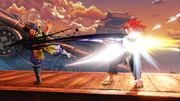
Bushin Gram
Old Zeku's movelist includes a move named "Bushin Gram" (武神倶羅無, the kanji for Gram are used in a form of ateji, specifically for their phonetic pronunciations instead of their meaning), where he kicks and produces a larger shockwave effect. The move is based on Hiryu's Gram, a special move from Marvel vs. Capcom which consists of a Cypher slash with extended reach. Its officially described as a "sharp kick, similar to the Iai sword fighting style"[7]. Coincidentally, Iaido is also the sword style used by Kuramoto.
Young Zeku's movelist includes two moves shared with Hiryu: Sankaku Tobi (or Triangle Jump, used by Hiryu in the NES Strider and Marvel vs. Capcom) and the Hassou Tobi (Hassou Jump, from Strider 2). A follow-up move from Sankaku Tobi (Bushin Shidenkyaku) is a dive kick off the wall similar to Hiryu's Jump/Leaping Kick in Marvel vs. Capcom.
Zeku's Critical Art (shared by both forms), Batsuzan Gaisei, has Zeku throw the enemy into the air via a backflip kick, followed by a flurry of strikes in mid-air, ending with Zeku performing three dash strikes from different angles and a descending kick into the ground. While the general aesthetic of the move resembles Guy's Bushin Muso Renge, the last part is very reminiscent of Hiryu's Ragnarok Hyper Combo, and is accompanied by the same slashing sounds and effects from his special kick moves, mimicking Hiryu's slashing during said Hyper Combo. When initiating the attack, young Zeku exclaims "Time to end this!", the same line Hiryu exclaims at the beginning of Ragnarok in Ultimate Marvel vs. Capcom 3 and Marvel vs. Capcom: Infinite.
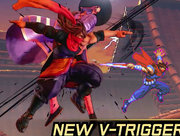
Zeku's V-Trigger II introduced in Street Fighter V: Arcade Edition, Karura Tenzan, has him performing a rising kick into the air and quickly following by switching forms and performing several spinning strikes at the airborne enemy with both his arms and hands fully extended. The move resembles a very simplified version of Hiryu's Savage Slash move, and the pose Zeku assumes during the attack is very similar to the pose Hiryu assumes during said move.
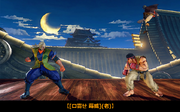
Zeku's V-Skill II Kuchiyose is based on Hiryu's Formation techniques: old Zeku's version (Kuchiyose - Shii) has Zeku summoning a hawk to drop firecrackers in much the same way Hiryu's Formation C summons Option C to drop a Parachute Bomb on the field. Young Zeku's version (Kuchiyose - Bii) instead summons a weasel which runs into the screen and flying kicks the enemy, based on Hiryu's Formation A1 not only in form (Hiryu summons Option B to rush at the enemy) but in animation (both Hiryu and Zeku point forward before the animal comes into the screen).
The two skill names are also a reference to the Options used in these moves: "Shii" and "Bii" are the Japanese pronuntiation of "C" and "B", a nod to Option C and Option B.
Old Zeku's V-Shift Break Bushin Murakumo is based and named after Hiryu's Ame-no-Murakumo, both being slashing strikes following a dash forward.
Other references[]
Other references to Hiryu and the Strider series found in Zeku.
- Zeku is stated to be a master of Taijutsu with a focus on kicks, Hiryu has been stated to have "superhuman mastery" of Taijutsu himself.
- When selling his services to Karin Kanzuki in his story mode, Zeku mentions intelligence, espionage and sabotage as works she should consider outsorcing. Those are usually the type of operations the Striders are said to perform in official descriptions.
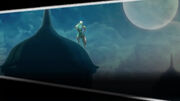
Last image in Zeku's story prologue
- The final artwork in his Character Story has Zeku standing over what appears to be an onion-domed rooftop overlooking a full moon. This image is a nod to the second-to-last area in the first stage of Strider, and resembles an old piece of artwork where Hiryu looks at the moon from the top of the Grand Mosque.
- Color 11 of Zeku's Battle Costume slightly changes the palette to more closely resemble Hiryu's colors. It lightens the blue on the uniform, darkens the brown on the shoulder ropes and paints the pouch belt to silver, to match the loose metallic belt it replaced. The tonfa hanging from Zeku's back is also recolored to closely match the Cypher's actual colors. This is noted on the official site, which lists this color and the default as being "dead-on for a certain striding character..."[8]. Color 13, on the other hand, gives Zeku a lavender and white scheme resembling Hiryu's palette from the Arcade original.
- Zeku's music theme includes near its end a remix of the opening motif from Hiryu's iconic theme, "Raid!".
- Young Zeku has a secret victory quote which is one of Hiryu's lines from the Arcade original: Kisamara ni sonna gangu wa hitsuyōnai[9] (roughly you don't need a toy like that, or "You are sending a toy into battle?" in English versions of the game). The line is translated "Such playthings are unnecessary" when Zeku is set to English.
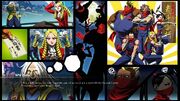
Zeku's ending in Arcade Mode
- In the Arcade Edition update, Zeku's ending in the "Street Fighter V" route of Arcade Mode features allusions to the Striders. In it, Zeku defeats Karin and (as part of a bet) forces her and her subordinates (her butler, Birdie and Ibuki) to form part of Zeku's "Global Ninja Corps", all five sporting Strider uniforms identical to Hiryu's (including the "Hi" kanji on their chests). A wooden sign behind them has written "Hiryu Corps" (飛龍戦隊) in red and "Strider" (素斗雷打, using ateji as in the Bushin Gram) in yellow.
- To complete Zeku's Option-themed animal partners, a monkey named Ei (徊衣(えい)) was intended to serve as Zeku's equivalent for Option A, but it couldn't show up in-game as V-Skills were only two.[10]
Cannon Dancer references[]
Street Fighter V director Takayuki Nakayama confirmed that Zeku's design and technique also pay respects to Cannon Dancer/Osman, the spiritual sequel to Strider developed by Isuke[11]. A few possible nods include:
- Young Zeku's default costume has a number of similarities to Kirin's design. This includes both characters wearing very similar sleeveless, backless shirts with an imprinted kanji, similar baggy pants, finger-less gloves (albeit orange instead of black), and a loosely similar hairstyles (although Kirin keeps his in a ponytail).
- Bushin Gram has two variations known as "Teki" and "Ban", named after two of the four Barbarian tribes bordering Zhou Dynasty China. Teki in particular is confirmed to have been used as a nod to Cannon Dancer[6], being the mercenary group Kirin belongs to. Teki is also connected to the Kuniang team, with the implication they are related or descended from them. "Bushin Gram - Teki" makes Zeku perform a kick in an upward angle, closely resembling Kirin's angled full-power roundhouse kicks in Cannon Dancer (which were based on the Kuniang's plasma kicks, incidentally).
- Zeku has one move called "Bushin Jakura" (Bushin Sparrow Net) in which he leaps up and performs a mid-air somersault, which can then be followed up by "Bushin Kirinkyaku" (Bushin Kirin/Qilin Kick), a mid-air turning circular kick which leaves a crescent trail of energy. The way Zeku animates during the somersault resembles the beginning part of Kirin's jump animation, and the Kirinkyaku (which is confirmed to be named in reference to Cannon Dancer[6]) closely imitates how Kirin performs kicks in mid-air, including the crescent arc of energy when fully powered-up.
Minor references in other games[]

Tong Pooh in the New Generation Secret File.
- One of the Dolls introduced in Street Fighter Alpha 3, the Chinese Jianyu, sports the same hairstyle as Tong Pooh, although it's unknown if this was intentional. This is kept in her appearance as a NPC in Street Fighter V.
- The Street Fighter III: New Generation Secret File has a small nod to Tong Pooh, showing her in a screen with text wondering if she'd become the "next Chun-Li", as Chun-Li wouldn't be added to the roster until the game's third incarnation.
- Artwork for Ultra Street Fighter IV reveals that one of Guy's scrapped ideas for alternate costume was based on Hiryu's appearance.
- The 2014 Strider features three references to Street Fighter:
- The color schemes for Fallen Striders Shouyo and Ouga are based on Guy and Ibuki, respectively.
- The achievement for defeating Xi Wang Mu is named "You Must Defeat Sheng Long", a reference to the infamous April Fools character Sheng Long, the supposed master of Ryu (just as Xi Wang Mu is the Winds' master), and the mistranslated win quote who gave birth to him.
- Tong Pooh was also referenced in the Street Fighter V online character encyclopedia hosted on the Capcom Fighters Network, in the entry for one of Street Fighter III's Judgement Girls (Toli), comparing her Chinese name to both hers and Chun-Li's. This reference was removed in the English localization of the entry, however.
- Many of Ibuki's costumes in Street Fighter V sport a long scarf covering her mouth, and some of her alternate colors end up giving her a scheme similar to Hiryu's (blue costume with red scarf). A long, red scarf included as part of her Schoolgirl Costume DLC, however, was explicitly stated to be a homage to Hiryu.[12]
References[]
- ↑ Capcom (1998). Official Marvel vs. Capcom website (Japanese). Support Characters Introduction. Retrieved from Archive.org. Accessed October 26, 2017.
- ↑ Capcom Staff (December 2012). "Akira Yasuda x Akira Nishitani Interview" (Japanese). Street Fighter Art Works Kiwami, Pg. 432. Capcom. ISBN 4-86-233381-8
- ↑ Yasuda, Akira (November 10, 2017). "Akiman's twitter" (Japanese). Accessed November 15, 2017.
- ↑ Zenji (February 1991). "Street Fighter II" (Japanese). Gamest (56). Pg. 3.
- ↑ Capcom (March 10, 2014). "Capcom Legends Chapter 3: The Running Ninja from the Future, Hiryu!" (Japanese). Capcom's official site. Retrieved from Archive.org. Accessed November 11, 2021
- ↑ 6.0 6.1 6.2 6.3 Staff (November 30, 2018). How to Make Capcom Fighting Game Characters (Japanese). Pg. 020. Born Digital. ISBN 4-86246-432-7.
- ↑ Capcom (October 2017). "Enter the Ring! Zeku" (English). Capcom Fighters Network official site. Accessed October 26, 2017
- ↑ Capcom (October 2017). "Zeku - Costumes", Battle Outfit 1 "Comments from Srgt. Ishida" (English). Capcom Fighters Network official site. Accessed November 15, 2017
- ↑ Reiji (October 25, 2017). "Goma399's twitter" (Japanese). Accessed November 15, 2017.
- ↑ Nakayama, Takayuki (April 21, 2023). "Nakayama's twitter" (Japanese). Accessed May 8, 2023.
- ↑ Staff (November 30, 2018). How to Make Capcom Fighting Game Characters (Japanese). Pg. 177. Born Digital. ISBN 4-86246-432-7.
- ↑ Harrison (June 22, 2017). "More School Costumes heading to Street Fighter V June 27th". capcom-unity.com. Accessed October 26, 2017
